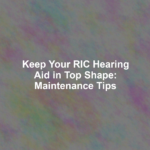Like a well-oiled machine, your telecoil technology functions best when itG??s meticulously cared for and regularly maintained. YouG??ve likely invested in this specialized equipment to enhance your auditory experience, be it for personal hearing aids or larger scale loop systems in public venues.
ItG??s crucial to understand that even the most advanced devices can succumb to everyday wear and tear, and itG??s your proactive measures that can make all the difference. By adopting simple daily cleaning rituals and performing regular performance checks, you can extend the life of your telecoil and ensure it operates at its peak.
However, there are a few nuances and expert tips that can aid in preventing common issues from cropping up. LetG??s explore how you can keep those silent gremlins at bay and maintain your deviceG??s pristine conditionG??after all, a little insight now could save you a great deal of inconvenience down the line.
Understanding Telecoil Technology
To fully benefit from your hearing aids, itG??s important to understand how telecoil technology works and how it can enhance your listening experience in various environments.
Telecoils, often called t-coils, are small copper coils integrated into many hearing aids and cochlear implants. TheyG??re designed to pick up magnetic signals from compatible sound systems and convert them into audio thatG??s tailored for your hearing needs.
Imagine youG??re in a bustling airport or attending a packed theater performance. YouG??re straining to hear announcements or dialogue over the background noise. ThatG??s where a telecoil becomes a game-changer. When you switch your hearing device to the t-coil setting, it receives a direct feed from the venueG??s sound system. This means youG??ll hear the sound clearly and directly in your ears, without all that pesky background noise.
Moreover, telecoils can also connect to loop systems installed in public spaces, such as churches, conference centers, and even some taxis. These systems transmit audio signals magnetically, which are then captured by your t-coil, allowing you to hear more clearly.
Daily Cleaning Rituals
Ensuring your telecoil-equipped hearing aids function optimally involves establishing a routine for daily cleaning. ItG??s crucial for maintaining sound quality and preventing malfunctions. Start by gently wiping the exterior with a soft, dry cloth to remove any debris or earwax. Avoid using wet cloths or harsh chemicals, as they can damage the device.
Next, inspect the telecoil and microphone ports. Use a soft-bristled brush specifically designed for hearing aids to clear away any accumulated dust or wax. Be careful not to insert the brush too far, as this could harm the internal components.
If your hearing aids have wax guards, check them daily. If you notice wax buildup, replace the guards according to the manufacturerG??s instructions. ItG??s a quick step thatG??ll save you from sound quality issues down the line.
Lastly, open the battery compartment and remove the batteries each night. This allows any moisture thatG??s collected during the day to evaporate, preventing corrosion and prolonging battery life. Just remember to place your hearing aids in a safe, dry place away from pets and children.
Regular Performance Checks
Regularly testing your telecoil-equipped hearing aids can help catch any issues before they become major problems. ItG??s crucial to ensure that the telecoil function is operating correctly, as itG??s indispensable for hearing clearly in public spaces with loop systems, like theaters and churches. YouG??ll want to set aside a specific time each week to check the performance of your hearing aids.
To start, find a venue with a loop system and switch your hearing aid to the telecoil setting. Can you hear the sound clearly? Is the quality consistent? If youG??re experiencing static or the sound isnG??t as crisp as usual, itG??s a sign that your telecoil might need professional attention. DonG??t ignore these signs; prompt action can save you from future inconveniences.
Additionally, you can test the telecoil at home using a loop listener, a handy tool that detects the signal strength and quality of the telecoil. If the signal is weak, itG??s time to schedule a maintenance appointment. Remember, youG??re not just maintaining a piece of technology; youG??re preserving your connection to the world around you. So, keep up with these regular checks to ensure your telecoil is always delivering its best performance.
Troubleshooting Common Issues
While regular checks can significantly reduce the risk of telecoil issues, you might still encounter occasional hiccups that require troubleshooting. If youG??re facing problems, donG??t panic G?? many common issues with telecoils can be addressed with some simple fixes. Here are a few things to check:
-
Weak or No Signal: If youG??re not picking up a signal or itG??s weaker than usual, ensure that the telecoil is switched on and your device is at the correct setting. Sometimes, itG??s just a matter of toggling a switch or adjusting the volume.
-
Interference or Static: Electronic devices and fluorescent lighting can sometimes interfere with your telecoil. Try moving away from these sources or turning off unnecessary electronics. If the static persists, your telecoil might need professional servicing.
-
Inconsistent Performance: This can be caused by battery issues or damage to the telecoilG??s wiring. Check your battery power and make sure itG??s properly seated. If the battery isnG??t the culprit, avoid attempting complex repairs yourself G?? consult with a specialist to ensure your device is handled with care.
Professional Care and Services
For specialized maintenance or complex issues, seeking a professionalG??s help can ensure your telecoil continues to function optimally. DonG??t hesitate to reach out to an audiologist or hearing aid technician when youG??re faced with challenges beyond simple at-home fixes. TheyG??ve got the expertise to diagnose and resolve intricate problems that might be impacting your telecoilG??s performance.
Remember, youG??re not just paying for a repair; youG??re investing in the longevity and effectiveness of your telecoil technology. Regular professional check-ups can catch potential issues before they turn into costly repairs. Think of these services as preventative care for your valuable device.
When you visit a professional, theyG??ll typically start with a comprehensive assessment. TheyG??ll check the telecoilG??s functionality, clean any parts that may have accumulated debris, and make adjustments to ensure itG??s working in harmony with your hearing aid or cochlear implant. If thereG??s a need for replacement parts or more advanced interventions, theyG??ll handle that too.
Make sure to keep a record of all professional services you receive. ItG??s not just good practice; it helps you track the care your device has received, and it can be useful if warranty claims or further technical support is needed. Trust professional care to keep your telecoil in prime condition.
Conclusion
So, youG??ve got the scoop on keeping your telecoil tech tip-top. Remember, daily cleaningG??s a must to ditch the grime.
Regularly check performance to catch any hitches early.
Run into a snag? DonG??t sweat it; most issues are quick fixes. But hey, donG??t skimp on professional tune-ups. TheyG??re your safety net, ensuring your gearG??s always ready to roll.
Stick with this plan, and youG??ll keep your telecoil technology in prime shape for years to come.










